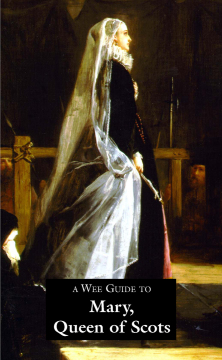Mary Queen of Scots: Wedding to Widowhood
On 24 April 1558, a Sunday, the population of Paris swelled owing to the large number of visitors who had travelled to witness the royal wedding, due to take place in
Notre Dame Cathedral. There were two versions of the marriage contract, and it would appear that the secret version was agreed to by Mary herself: the reasons for her agreeing may not have been
simple political naiveté. Certainly Mary would have received much advice from her Guise-Lorraine relatives, and as marriage into the royal family of Valois would be to their advantage they would not
see the signing away of the Scottish kingdom as a problem. Equally Mary was fond of, if perhaps not in love
with, François and marriage to him would bring benefit to herself and her kingdom, and as she was only 15 she would probably not consider the fact that she might die childless as likely.
The bride and groom were physically quite dissimilar. Mary was tall, elegant and personable, whereas François was small, unhealthy and did not have an endearing personality. The
eldest child of Henri de Valois and the notorious Catherine de Medici was doted on by his parents. Henri and Catherine had had problems conceiving for some years, and as a result his mother was
especially protective. Despite any failings that the cynics in the French court might ascribe to the Dauphin, the young couple appear to have been fond of each other.
The wedding was, despite any concerns which the Scots might have had, a great celebration. It was full of spectacle, music, colour and cheering. The bride and groom were dressed in
expensive, magnificent clothes and bejewelled as was expected of queens and kings. Mary surprised French custom by appearing in a white dress. Traditionally, white was a mourning colour for the royal
court in France, and brides usually wore silver, gold or purple. Mary also wore a gold crown covered with pearls, rubies and sapphires.
The wedding party proceeded from the Louvre to the Cathedral of Notre Dame, passing through the Paris crowds; and in keeping with the marriage customs of the time, the actual
wedding vows were taken at the doors of the cathedral. There then followed a Mass inside. The festivities continued with a banquet and ball, and the general atmosphere of celebration continued for
several months.
Mary was now queen of one country and the prospective queen of another and her future appeared bright and rosy. Mary even had a good relationship with her powerful mother-in-law
who, because of her obsession with her son, many thought may have been jealous of Mary. Mary was a happy and likeable person compared to Catherine’s scheming and plotting tendencies. Mary was also
very tall, almost six feet, had auburn hair and a clear skin, and was regarded as quite a beauty. Catherine on the other hand was short, dark and older. But Mary and Catherine had a shared interest –
the Dauphin’s health and happiness, and the belief that he would eventually rule France as God’s chosen divine monarch.
Added to the couple’s claim to two royal titles, Henri II also announced that both François and Mary were the rightful heirs to the English crown. When Mary Tudor died she was
succeeded by Elizabeth, Henry VIII’s second daughter, who as a Protestant made it her objective to overturn her half-sister Mary Tudor’s Catholic policies and re-introduce Protestant ones. As Rome
had never regarded Henry as divorced from his first wife, any offspring born while Catharine of Aragon lived was regarded as illegitimate, especially one who was Protestant. As James IV had married
Henry VIII’s sister, Margaret Tudor, Mary had some claim to the English crown which Rome supported, and in which her father-in-law could also see political and economic advantages.
The situation in Scotland was still uncertain as the pro-French and pro-English parties fought for control. As Regent Mary of Guise’s pro-French policies contributed to the revival
of pro-English attitudes: either the result of the presence of Frenchmen in the royal household and their perceived power, or her adoption of a more anti-Protestant stance than hitherto, or a
combination of both. Discontent with the Catholic church grew among certain sections of the Scottish population, and found a voice by the end of 1558 and the beginning of 1559. In January the
Beggars’ Summons was nailed to the doors of friaries throughout the land. It stated that friars should leave, and hand over their goods and monies to the poor. There was an economic aspect to this
document as much as a religious one. At the same time, Châtelherault, who was by this time pro-English, was in communication with the Englishman Sir Henry Percy, as the Protestants were concerned
about the threat of a French Catholic invasion.
Despite, or because of, individual ambitions or fears, it was agreed between France, Spain and England to sign the Treaty of Cateau-Cambrésis in April 1559. By this agreement,
there was to be a period of peace in Europe and a marriage between Princess Elisabeth de Valois, Mary’s sister-in-law, and Philip II of Spain, and the celebrations to mark this betrothal were to be
momentous in more than one way. Philip himself did not visit France and a proxy wedding was to be held in June, at which time the main festivities were to take place.
Henri II was very fond of jousting and so several jousting tournaments were arranged in which the king was to participate. Some time before the actual tournament, the astrologer
Nostradamus told Catherine de Medici of a dream he had had. In the dream he saw a fight between two lions, one older than the other. The lions fought twice and in the second fight the young lion
gouged out the eye of the older one, who died of the wound. Henri’s escutcheon, his heraldic shield, was engraved with a lion. Catherine, along with many others of that time, believed in divination
through a variety of methods and it may have been that she believed Nostradamus’s prophecy – she was not, however, able to persuade her husband against taking part. Clothed in black and white, the
colours of his mistress Diane de Poitiers, Henri successfully jousted three times. He is then reported to have challenged one of his opponents to a second bout but on this occasion his opponent’s
lance broke, a splinter going into the king’s eye. Attended by his family, Henri died from his wound ten days later and François was declared king of France.
Henri II was buried at St Denis and François crowned at Rheims in September 1559. There now began a power struggle for control over the young king – his mother against his
uncles-in-law, the Guises. François was entirely unsuited to, or perhaps unready for, his regal responsibilities; and showed little interest in affairs of state, preferring to spend time hunting,
which he enjoyed with a passion despite his poor physique. Mary’s uncles attempted to persuade the king to attend to his duties, but with little success. His mother began to shift her attention to
her second son, Charles, as a possible heir to the throne if François and Mary produced no children, and one whom she would be able to control without interference from the Guise faction. François
and Mary found themselves caught in an unenviable position: the freedom and innocence of their childhood had quickly passed.
Pressures on Mary increased as any possible signs of pregnancy were looked for with anticipation; which added to the increasingly disturbing news from Scotland. Religious problems
had increased for the Regent as more Scottish nobles joined the Protestant cause. After Mary became Queen of France more French troops were sent to Scotland and garrisoned at Leith. In October the
Protestant lords, headed by Châtelherault, marched on Edinburgh and proceeded to suspend Mary of Guise from the Regency. This provisional government may have held the capital of the country, but it
lacked the capital required to administer and further their cause, and by November they had to evacuate to Stirling after an unsuccessful attack on Leith. Mary of Guise re-took Edinburgh and restored
Catholic Mass in the city. The next couple of months resulted in stalemate as it became clear that neither group would be able to take power without outside help. English help was requested by the
Protestant party and as Fife was held as a stronghold by the French, the English fleet sailed north in order to cut their communication route with the French mainland.
The French still held Leith, but in February 1560 the Treaty of Berwick was signed between Elizabeth of England and the Scottish Protestants, Elizabeth having promised to help
their rebellion against Mary of Guise and to assist their campaign against the French. The siege of Leith had begun by the end of March 1560 but it was soon clear that it was not going to end
quickly. Mary of Guise moved into Edinburgh Castle as a safer alternative to
Holyrood Palace on 1 April, but she was not to see the end of the siege as
she died, of dropsy, an accumulation of body fluid, on 11 June. Her death enabled the hostilities to end but was not necessarily to make things easier for her daughter.
The Treaty of Edinburgh was signed on 6 July 1560 and it was agreed that both the English and French troops would withdraw from Scotland, and François and Mary would give up their
claim to the English crown and recognize Elizabeth as rightful queen of England. The following month the Scottish parliament accepted a reformed Confession of Faith, rejected papal authority and
forbade the practice of the Mass; and in order to give authority to their actions they asked François and Mary to ratify these acts. Mary, grieving in France, had more loss ahead.
Her Guise relatives needed to find a suitable Regent for Scotland who could hold back the tide of Scottish protestantism, but unfortunately another crisis changed their plans.
After a day’s hunting in November 1560 François returned complaining of a sore ear. Earache was one of his frequent ailments and little was thought of it. Surely it was only the cold autumn weather
which had exacerbated an old infection? But there was a rumour that François was so disliked by his people, poison had been poured into his ear while he slept. After fainting, François developed a
fever and despite being nursed continually by his wife and his mother, the infection spread to his brain and he died on 5 December. Mary was now a widow and no longer Queen of France. Her powerful
mother-in-law took over the running of the state, on behalf of Charles IX, François’s younger brother, and Mary’s immediate future was uncertain.
© Joyce Miller & Martin Coventry 2018









